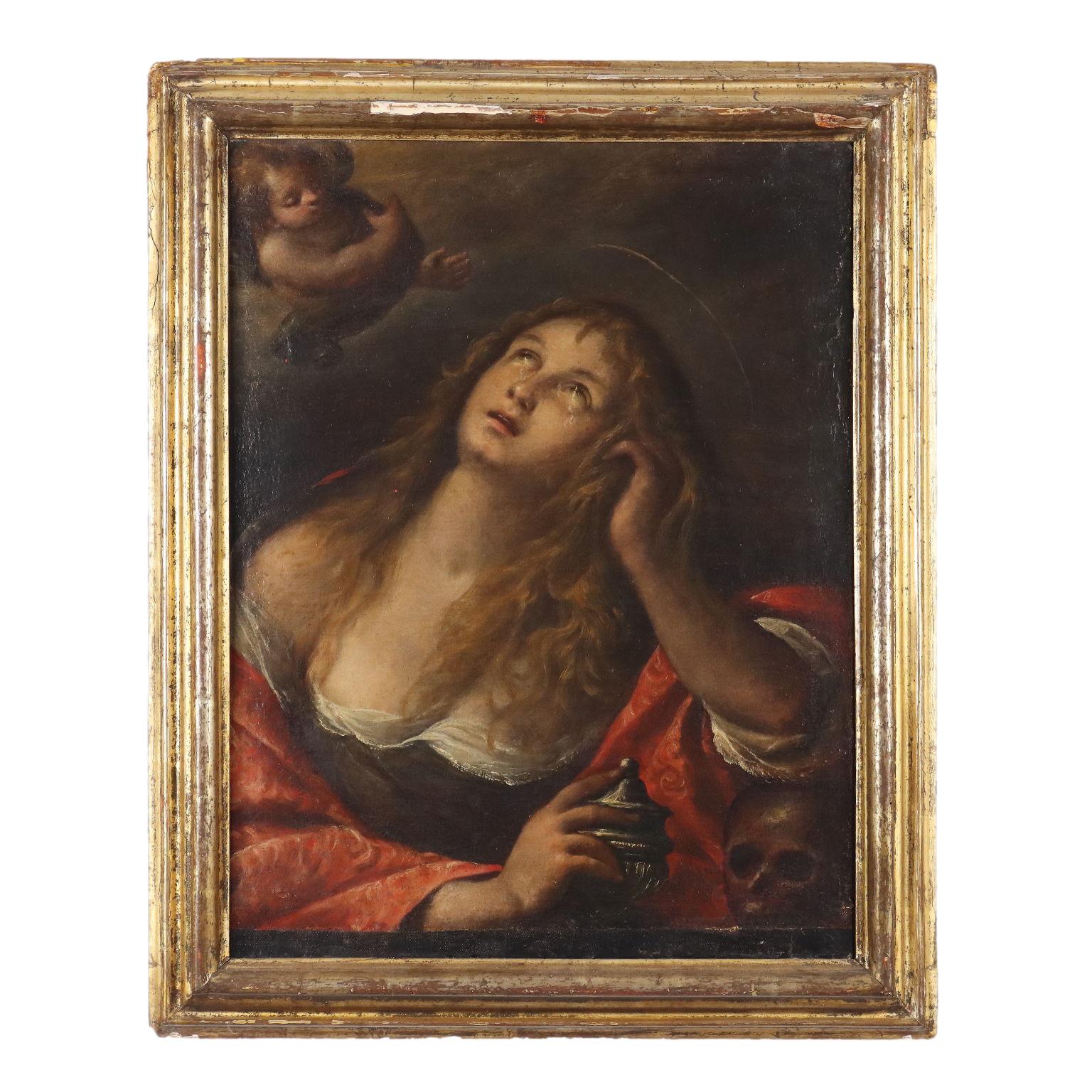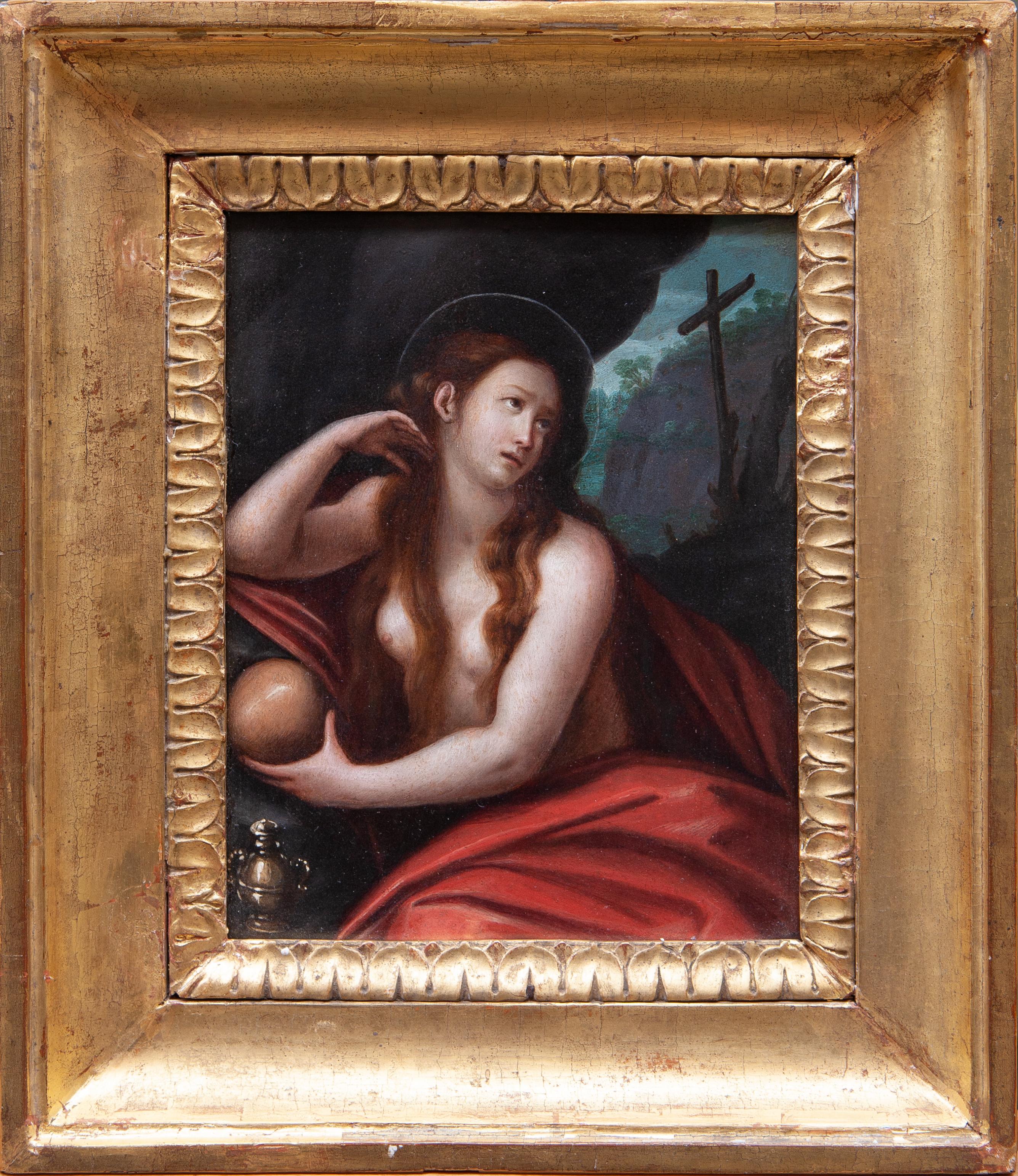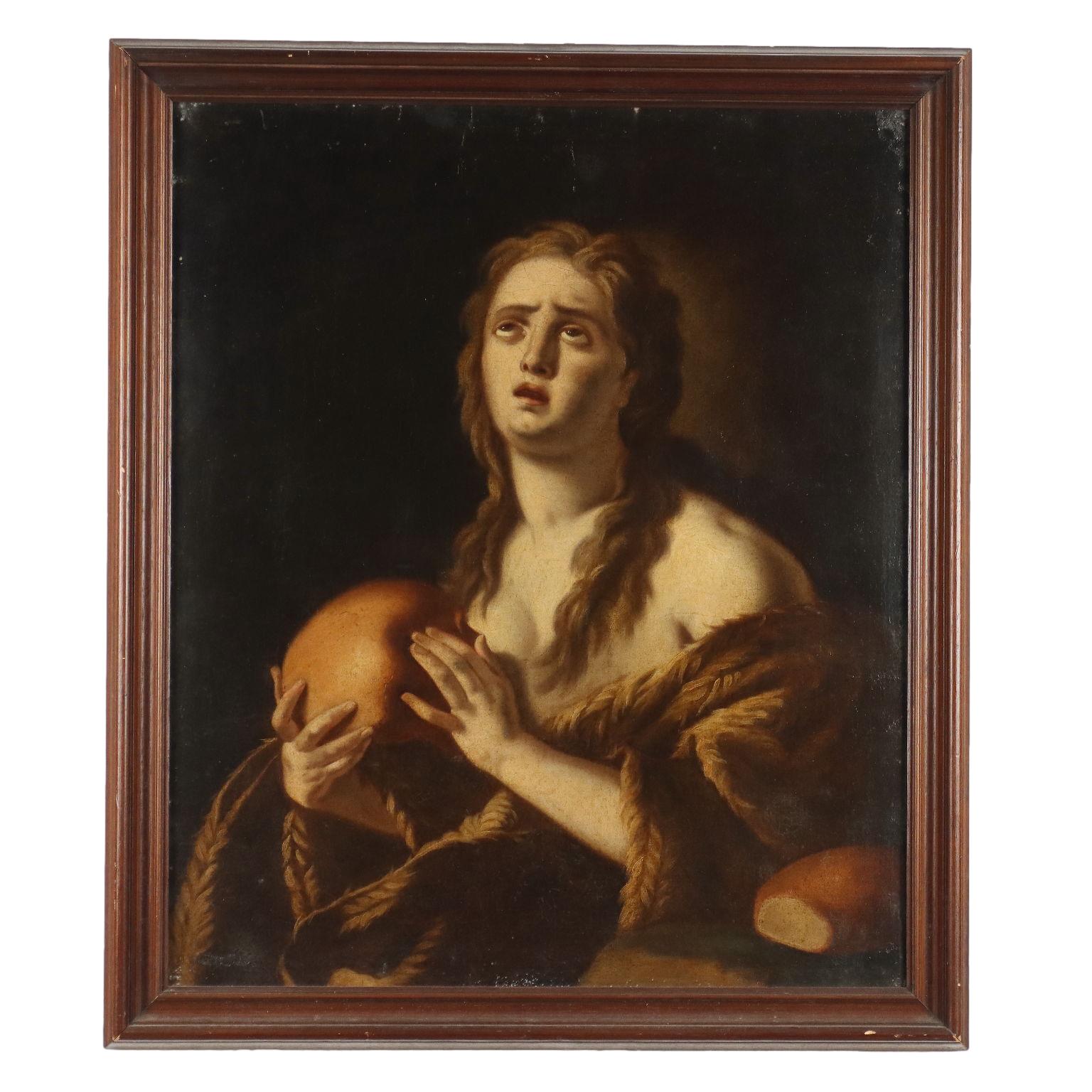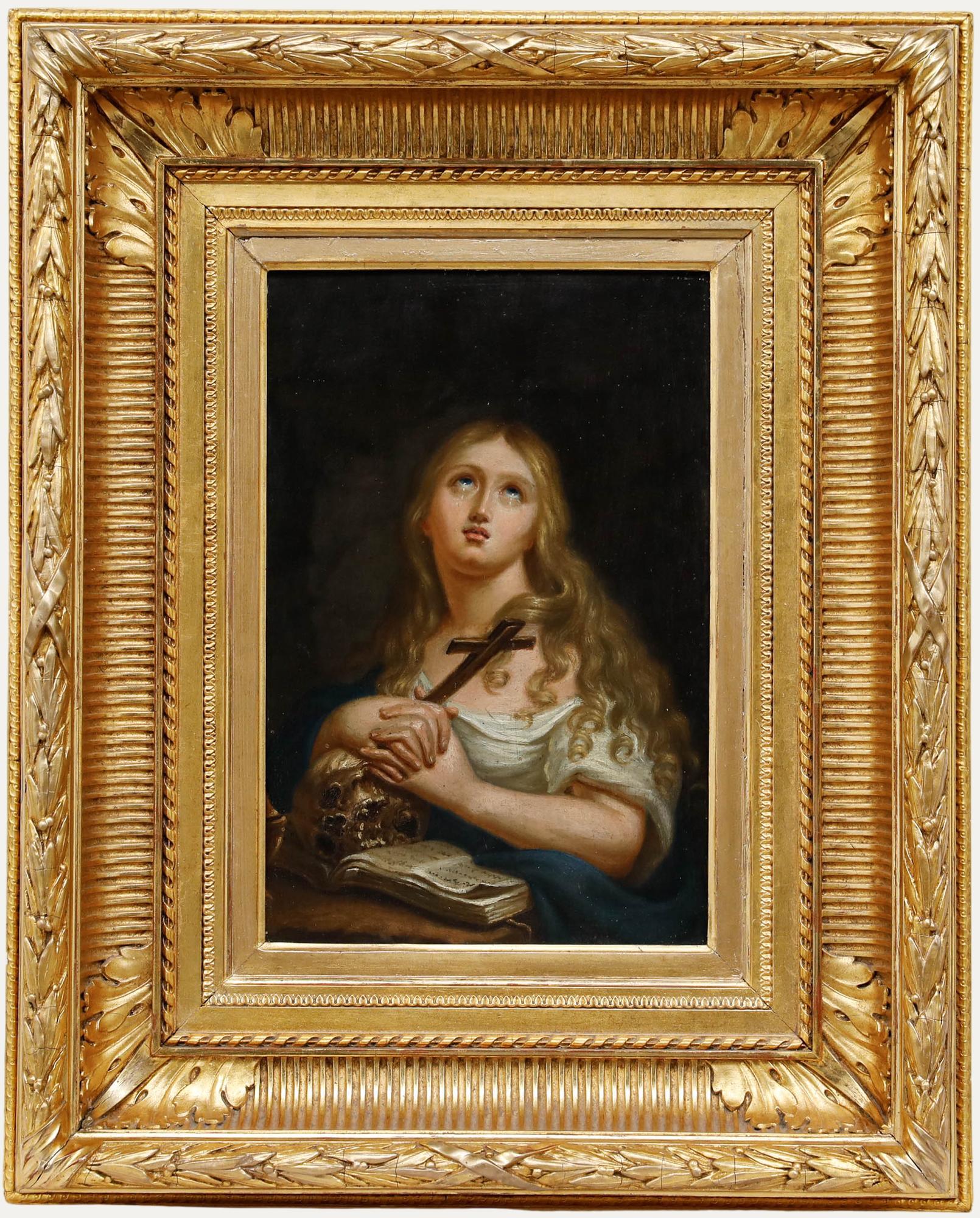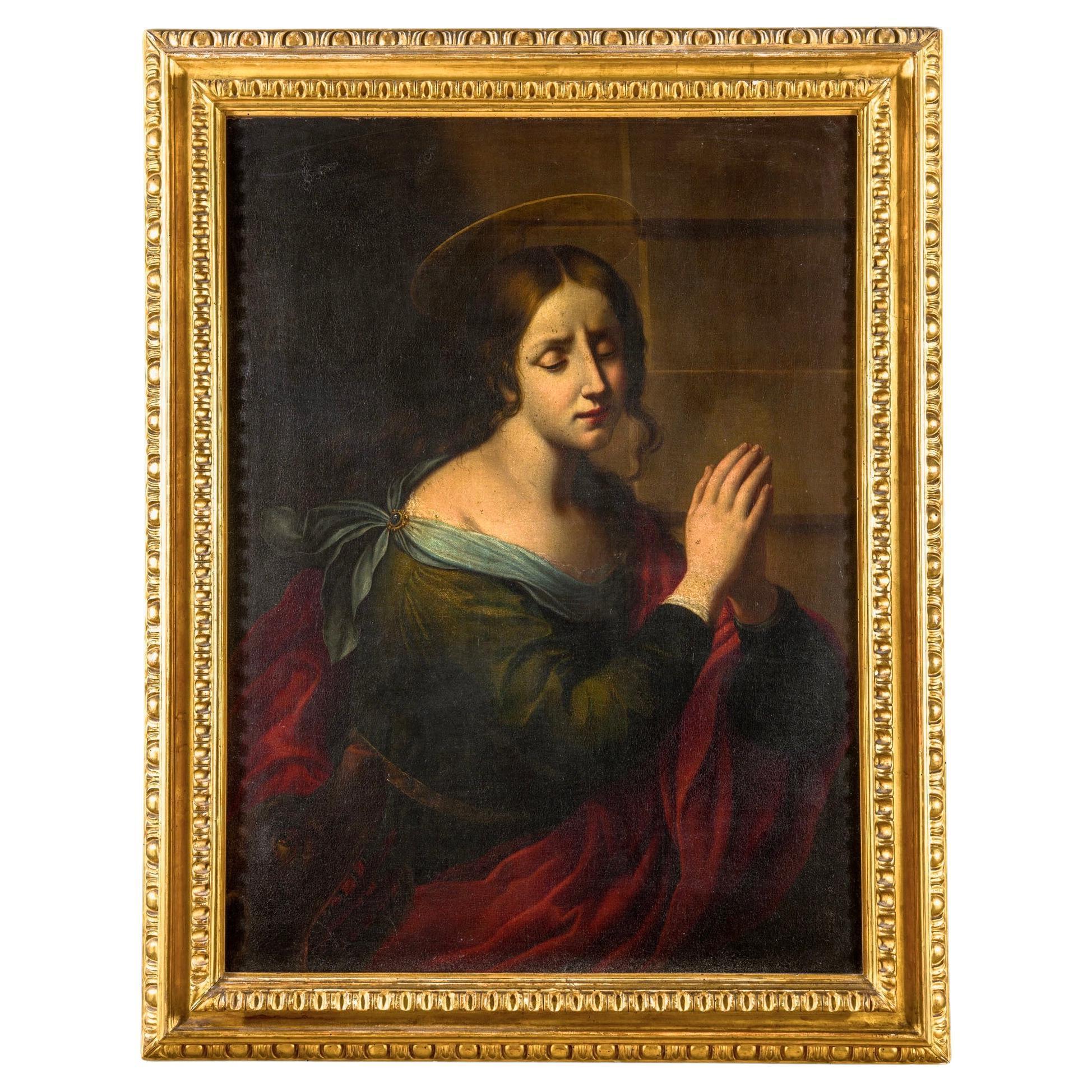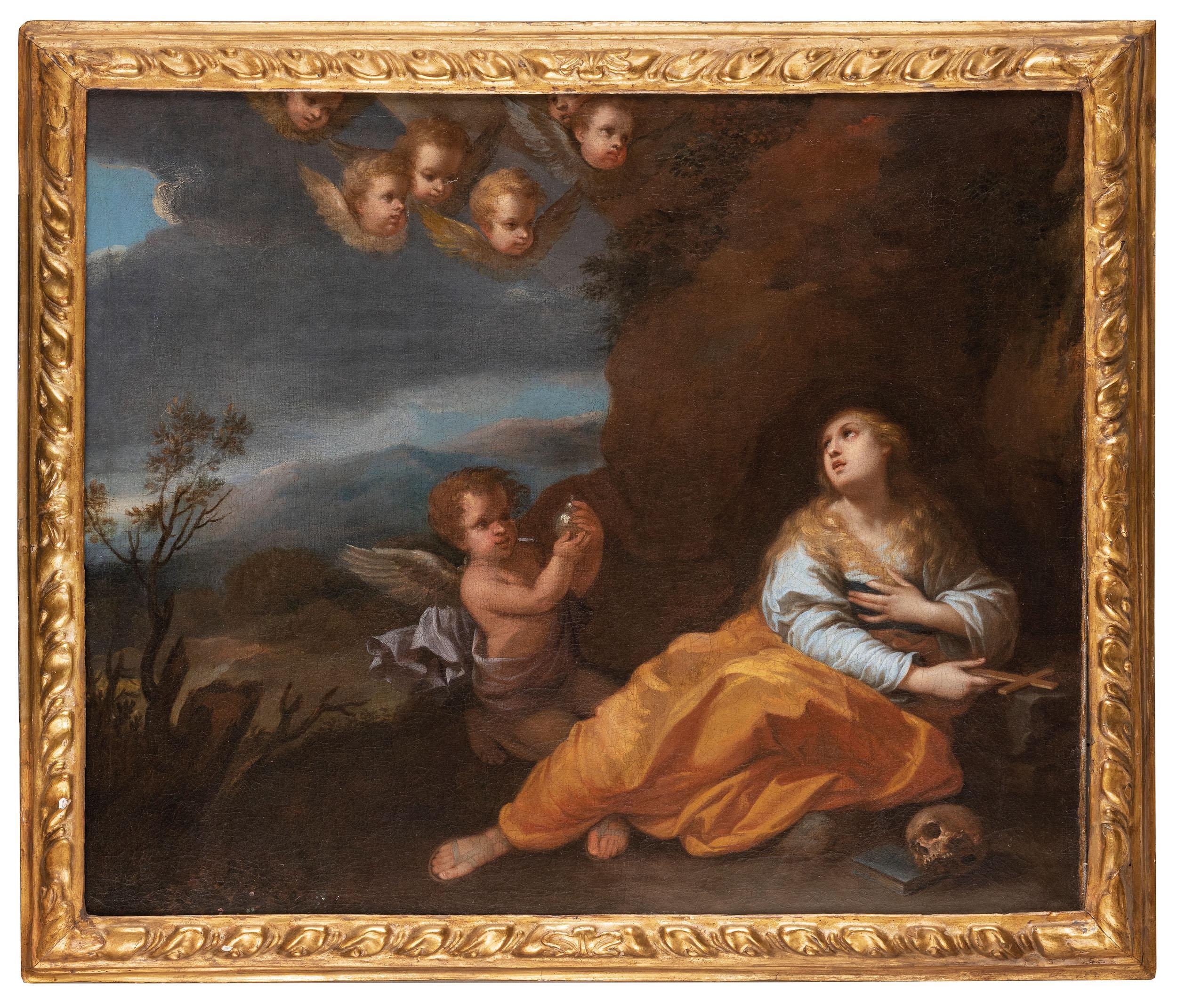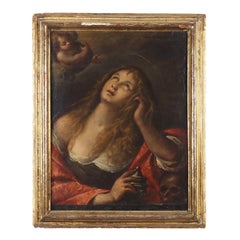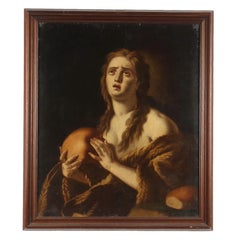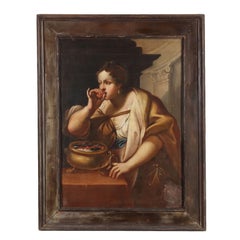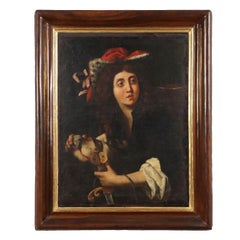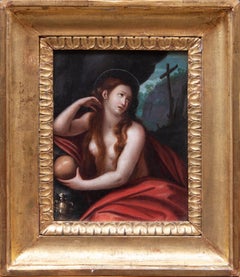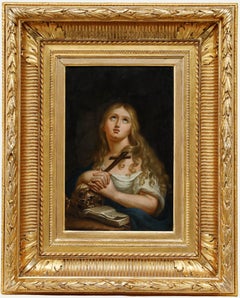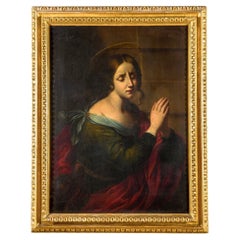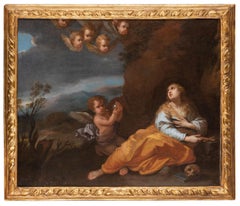Items Similar to Penitent Magdalene, c. 1750.
Want more images or videos?
Request additional images or videos from the seller
1 of 10
Penitent Magdalene, c. 1750.1750s
1750s
$28,122.51
£20,890.33
€23,500
CA$38,796.98
A$42,648.55
CHF 22,414.12
MX$517,908.75
NOK 279,610.54
SEK 264,911.33
DKK 178,894.17
About the Item
Painting done in oil on canvas. The figure of Magdalene is depicted here, in keeping with tradition, with long red hair; with a gesture of sorrowful dedication she fixes her gaze on the crucifix, which she holds with her left hand pressed against her right arm, the latter in turn folded in a sign of collected penitence.
The whole body is rendered with a splendid opposing twist, which has the effect of making the viewer feel the tension of the moment experienced by the saint. On her left is visible the skull, her traditional attribute, and in the background we can make out the outline of the cave in which she is placed.
The part of the body emerges, thanks to the intense brightness of the arms, connected to the red ochre hues of the hair and face, also thus accentuating the erotic character of the scene, recalling the exuberant painting of Rubens, who had great influence on Crespi's work.
This captivating and highly pleasing figure of Magdalene follows the widely popular trend in the 1600s and 1700s of depicting saints with an undertone of human sensuality, revealing the patrons' preference for sacred themes imbued with secular elements.
The present painting, datable to about the mid-1800s, is derived from the original versions by Crespi, a very active painter of Bolognese origin, of whom at least two versions are known.
The first, kept at the Bologna picture gallery, formerly from the Florentine Loeser collection, later acquired by a private Englishman, was purchased by the picture gallery in 1996.
The second, closer to ours in the design of the details, was part of Angelo Cecconi's collection in Florence, then acquired in 1947 in the Briganti collection, then passed to a private collection in Como, was auctioned at Dorotheum in 2018.
Giuseppe Maria Crespi, known as Lo Spagnuolo, was an indefatigable and prolific artist, totally devoted to his painting activities; at least 300 works are surely his autograph, already documented years ago by Mira Merriman.
An early detailed account of his life is left to us by Abbot Giampietro Zanotti in his "Storia dell'Accademia Clementina" printed in Bologna in 1739, and then more news comes to us from the writings of his son Luigi, also a painter.
Their accounts show how Crespi surrounded himself with a considerable number of young painters, whom he had in his workshop, along with his three painter sons, Luigi, Ferdinando and Antonio Liborio.
To all, on the strength of his experience, he never ceased to recommend the exercise of copying, "that is why he continually exhorted his pupils to imbibe the manners of great men, in order to have them then present to their imagination, when they operated: that is finally, how he formed in his own way."
While there are no elements to glimpse direct interventions by the master in the present painting, its high pictorial quality, combined with some details of luministic rendering, and the identical measurements to the two original versions by Crespi, may lead us to speculate that it is a copy made in his own sphere, by some of his pupils or children.
- Creation Year:1750s
- Dimensions:Height: 37.8 in (96 cm)Width: 29.53 in (75 cm)Depth: 1.97 in (5 cm)
- Medium:
- Circle Of:Giuseppe Maria Crespi, Lo Spagnuolo (1665 - 1747, Italian)
- Period:
- Condition:
- Gallery Location:Milan, IT
- Reference Number:1stDibs: LU680313993512
About the Seller
4.8
Vetted Professional Seller
Every seller passes strict standards for authenticity and reliability
Established in 2017
1stDibs seller since 2017
126 sales on 1stDibs
Typical response time: 3 hours
- ShippingRetrieving quote...Shipping from: Milan, Italy
- Return Policy
Authenticity Guarantee
In the unlikely event there’s an issue with an item’s authenticity, contact us within 1 year for a full refund. DetailsMoney-Back Guarantee
If your item is not as described, is damaged in transit, or does not arrive, contact us within 7 days for a full refund. Details24-Hour Cancellation
You have a 24-hour grace period in which to reconsider your purchase, with no questions asked.Vetted Professional Sellers
Our world-class sellers must adhere to strict standards for service and quality, maintaining the integrity of our listings.Price-Match Guarantee
If you find that a seller listed the same item for a lower price elsewhere, we’ll match it.Trusted Global Delivery
Our best-in-class carrier network provides specialized shipping options worldwide, including custom delivery.More From This Seller
View AllPainting Penitent Magdalene 17th century
Located in Milan, IT
Oil on Canvas. Lombard school of the seventeenth century.
According to classical iconography, the penitent Magdalene is depicted with tears in her eyes, her hair down, unkempt, hold...
Category
17th Century Other Art Style Figurative Paintings
Materials
Oil
Painting Penitent Magdalene 17th century
Located in Milan, IT
Oil on canvas, applied to wooden plate.
The saint is depicted in the foreground, half-length: the naked torso of the body is partially covered by a fur falling from the shoulders, ov...
Category
17th Century Other Art Style Figurative Paintings
Materials
Oil
Painting The Suicide of Portia 18th Century
Located in Milan, IT
Oil on Canvas.
The woman depicted in the scene can be traced back to Portia, the Roman noblewoman who was the wife of Brutus and thus lived in the first century BCE: according to le...
Category
18th Century Other Art Style Figurative Paintings
Materials
Oil
Painting David with the Head of Goliath 17th century
Located in Milan, IT
Oil on Canvas. Central Italian school of the 17th century.
The painting recalls in pictorial style the production of Angelo Caroselli (1585-1652), a Roman Baroque artist who was a pa...
Category
17th Century Other Art Style Figurative Paintings
Materials
Oil
Painting Our Lady of St. Jerome, 17th-18th century
Located in Milan, IT
Oil on Canvas. Emilian school of the 17th-18th centuries.
This is an early copy of Correggio's famous panel painting entitled La Madonna di San Girolamo or Il Giorno (Our Lady of St....
Category
18th Century and Earlier Other Art Style Figurative Paintings
Materials
Oil
Painting Bathsheba at the Bath 18th-19th century
Located in Milan, IT
Oil on Canvas. The large painting, echoes the pictorial modes of the 17th century but is of later date, and was made on a canvas applied over an older one.
The scene recounts the bib...
Category
18th Century Other Art Style Figurative Paintings
Materials
Oil
You May Also Like
Penitent Magdalene - 17th century painter
Located in Como, IT
Penitent Magdalene
Italian painter of the 17th century
Oil on copper in gilt frame
Size: 22x17 cm (33x28 cm including frame)
Mary Magdalene is the repentant sinner who washed Jesus'...
Category
Mid-17th Century Figurative Paintings
Materials
Copper
Fine 18th Century Oil - Mary Magdalene
Located in Corsham, GB
A striking 18th century oil depicting a pious Mary Magdalene. The artist portrays the saint with long, flowing blonde hair and penitent tears in her eyes. A skull at her hands remind...
Category
Early 18th Century Figurative Paintings
Materials
Oil
17th Century Onorio Marinari Italian Religious Painting
By Onorio Marinari
Located in Roma, IT
A very important painting by the great artist of the Florentine school, Onorio Marinari.
Dr. Silvia Benassai has confirmed Marinari’s authorship of the Saint Margaret of Antioch; ava...
Category
Mid-17th Century Baroque Portrait Paintings
Materials
Canvas, Oil
Saint Mary Magdalene The Penitent
Located in Paris, Île-de-France
Nicolas LOIR (Paris, 1624 – 1679)
Penitent Saint Mary Magdalene
Oil on canvas,
58 x 71 cm
Unsigned
Circa 1665–1675
Trained under Simon Vouet and later Sébastien Bourdon, Nicolas ...
Category
17th Century Old Masters Figurative Paintings
Materials
Canvas, Oil
Penitent Mary Magdalene c1750 Oil on Copper Old Master
Located in Holywell, GB
A finely painted picture, possibly of the penitent Mary Magdalene, painted in oil on to a copper plate and dating to c1750.
Condition
Two old touch ins, tiny chip to the forehead...
Category
1750s Old Masters Figurative Paintings
Materials
Oil
18th-Century Venetian School, Mary Magdalene, Noli Me Tangere
Located in Cheltenham, GB
This late 18th-century Italian oil painting fragment depicts Mary Magdalene kneeling alongside an alabaster jar. Christ’s hand is partially visible above, along with his robes, which...
Category
18th Century Italian School Figurative Paintings
Materials
Oil, Canvas
More Ways To Browse
Di Mano In Mano
Crespi Painting
Giuseppe Maria Crespi
Alabama Artist
Dutch Girl
Jean Renoir
Mexican Expressionist
Oil Painting 18 Century
Oil Painting Little Girl
Oil Paintings 70 X 55
Ophelia Art
Painter Walker
Shalom Of Safed
Venezuela Painting
Very Large Antique Oil Painting
Victorian Painting Children
Vintage Clowns Clowns Circuses
Will Street
